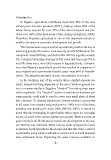Page 667 - 2015-37
P. 667
Introduction
In Nigeria, agriculture contributes more than 30% of the total
annual gross domestic products (GDP), employs about 68% of the
labour force, account for over 70% of the non-oil exports and pro-
vides over 80% of the food needs of the country (Adegboye, 2004).
Therefore, Nigerian agriculture is one of the important sectors of
notable relevance in economic development and growth.
The Government recognizes that agricultural growth is the key to
achieving poverty alleviation, food security, and the Millennium De-
velopment Goals (MDGs), and that further effort is urgently needed.
The Country Partnership Strategy (CPS) notes that from mid-70s to
mid-90s there was a nine-fold increase in degraded lands. It empha-
sizes that Nigeria’s agricultural growth has resulted in expansion of
area cropped and recommends that the sector must shift to intensii-
cation. The irrigation potential is only very partially developed.
In the Northern part of the country where rainfall amounts are
small, farmers had long depended on the use of shallow ground wa-
ter in a manner similar to Egyptian “shadoof” for raising crops espe-
cially vegetables. The “shadoof” system is very labour intensive and
consequently, could only be used to cover very small plots of about
half a hectare. To increase production, farmers started to use pumps
to lift water from streams and ponds prior to 1980; most of the direct
pumping was practiced in Kano State (NFDO, 2005). It would be
noted that direct pumping is only feasible where there are perennial
source of water at the surface (stream and ponds). These sources are
quite limited in the North and as a result, the development of dry sea-
son farming was restricted. Water bearing sands and gravels occurs
as shallow depth beneath the lood plain and that this water could be
exploited by using simple methods of construction of small diameter
tube wells/wash bores. Exploiting the water resource available on
-2-

